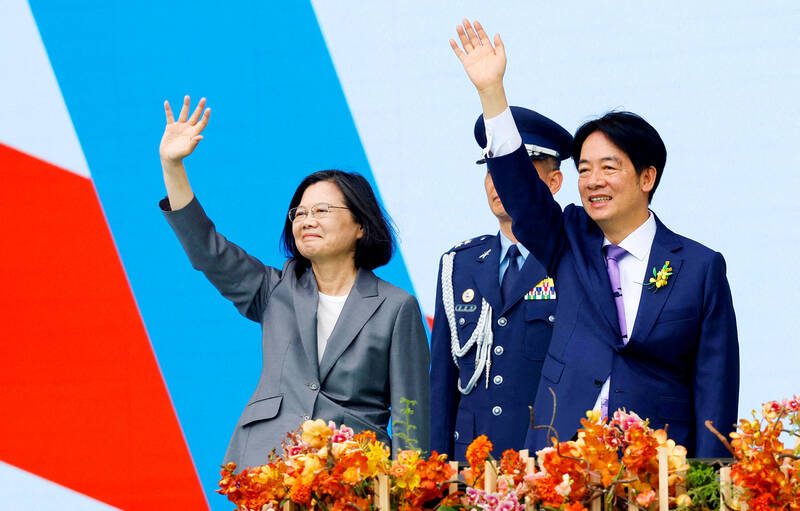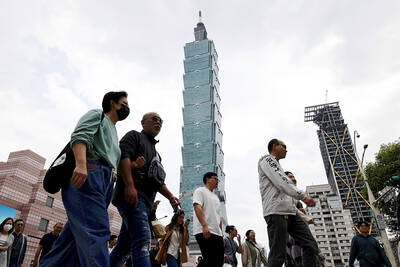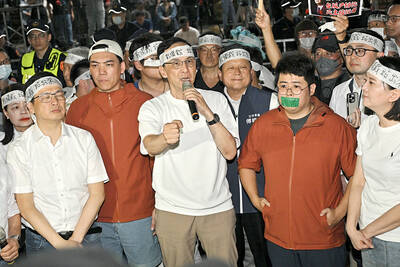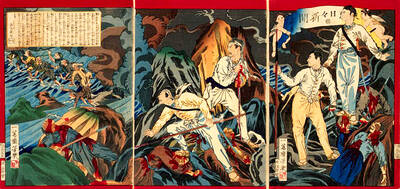The media abounded with takes on President William Lai’s (賴清德) address, making apples and oranges comparisons between the speeches of the former bureaucrat Tsai Ing-wen (蔡英文) and the former legislator and city mayor Lai. This comparison could only favor Tsai, steeped in the sharp, tight-lipped curtness of the bureaucracy, over Lai, a lifelong politician and talker.
As so many of us predicted, there was much disingenuous repetition of Lai’s “I’m a pragmatic worker for Taiwan independence” to suggest that Lai is some kind of out-of-control firebrand — as if Tsai were not equally a pragmatic worker for Taiwan independence. What do foreign observers think was happening here for the last eight years? Increasing subordination to the People’s Republic of China (PRC)?
Never mind that Lai’s cabinet has much in common with Tsai’s. Never mind that the speechwriters and thinkers are basically the same people, drawing on a common pool of representations, symbols and ideas.

Photo: Reuters
The widely disseminated, ineptly titled Financial Times piece, “China has a point about Taiwan’s Leader” (Kathrin Hille, May 21, 2024) — the PRC doesn’t have a point, it has a complaint — saw observers tsk-tsking and nodding to each other, with the wink-wink intent of smearing Lai as a wild-eyed independence fanatic who could plunge the region into war. Readers will have to decide whether these observers were too lazy to use Google, or simply not politically inclined to do so.
Lai observed in his speech: “This tells us clearly: the Republic of China and the People’s Republic of China are not subordinate to each other.” The Financial Times then cites an analyst that supports the Chinese Nationalist Party (KMT) to inform its readers that this is a major break. Kudos to the Financial Times for pointing out that this was likely hair-splitting, and for noting the stance of the people it sourced comments from.
But the outlet could have gone further.

Photo: AP
IN TSAI’S WORDS: NO SUBORDINATION
The truth is that Lai’s comments were Tsai’s policy as well. Consider this Mainland Affairs Council (MAC) press release of Oct. 13, 2021, titled: MAC Calls on the CCP to Rationally Face Up to Political Parity between the Two Sides: “ROC and PRC not Subordinate to Each Other” Is a Fact and Cross-Strait Status Quo. Why didn’t the MAC get the memo about the two sides not being subordinate? Because Tsai herself said it on Oct. 10 in her national day speech.
“Let us here renew with one another our enduring commitment to a free and democratic constitutional system, our commitment that the Republic of China and the People’s Republic of China should not be subordinate to each other.”
The MAC was simply reiterating her position, one of her “four commitments” from that speech.
I look forward to that glorious day when the clearly isolated land of foreign observers finally gets the Internet.
Note the context of Tsai’s 2021 remark that the ROC and the PRC are not mutually subordinate. In the paragraphs before she first lists all the bigwigs from the two other parties, the KMT and Taiwan People’s Party (TPP) present. She next notes how their presence is “one of the beautiful scenes in Taiwan’s democracy.” Then she observes that the ROC and the PRC are not subordinate to each other.
She wasn’t aiming that remark at the PRC. She was twitting the pro-China parties and especially the KMT, over their concealed creed that the PRC is subordinate to the ROC!
There’s nothing like a skilled bureaucrat for subtle verbal cruelty.
Tsai’s regular criticisms of the PRC for “escalation of their military intimidation, diplomatic pressure, trade obstructions and attempts to erase the sovereignty of the Republic of China (Taiwan)” — see her 2022 National Day Address — are completely consistent with the view that there are two countries on each side of the Taiwan Strait. Lai simply followed this route.
Trivia question: which of the last four ROC presidents is widely credited with playing a major role in forming President Lee Teng-hui’s (李登輝) “special State-to-state relations” theory? In fact, after the National Day speech of 2021, Beijing whined that Tsai had “revived the doctrine first adopted by Taipei in 1999” (summary from South China Morning Post, Oct. 13, 2021). That’s right, 1999.
“The President said that the sovereignty of the Republic of China is both exclusive and complete, just like that of the United States, Britain or France…”. Exclusive! That was Lee Teng-hui, in 1997.
Also indicative was which entities reached for the line that Lai had broken new ground: the KMT and the PRC. FocusTaiwan ran a piece on the views of Chinese scholars arguing that Lai’s speech was more pro-independence than previous presidents. This is the obvious PRC line, a signal to its servants and fellow travelers abroad about what to be saying.
Meanwhile KMT Chairman Eric Chu (朱立倫) said that Lai “made the ‘two-country doctrine’ conspicuous,” and said this was different from Tsai’s adherence to the ROC Constitution and the Act Governing Relations between the People of the Taiwan Area and the Mainland Area (臺灣地區與大陸地區人民關係條例).
If foreign commentators spread this line, who are they getting in bed with? If the “punishment” drills of the PRC were planned long in advance, does it matter what Lai said in his speech?
It’s almost as if commentators are looking for constructions they can use as excuses for PRC military aggression and adventurism. “Tell me again,” as a longtime observer noted, “how the US is changing the status quo.”
CENTERING TAIWAN
Lai using “China” more than Tsai did, that too is a natural evolution of her policies and an inevitable, important need. Over the last two decades usages have shifted. More and more one hears “China” instead of “the mainland” (大陸) in ordinary conversation. Rhetorical separation of China is also a more inclusive pro-Taiwan shift: pro-PRC nattering that the two sides of the Strait are one is a deeply racist, Han-centered formulation that excludes Taiwan’s indigenous peoples, orientalizing and isolating them as a montane “other.”
The shift to a Taiwan-centered discourse is also part of Tsai’s package. As Courtney Donovan Smith pointed out in a perceptive piece at Ketagalen Media after her 2020 inaugural speech, Tsai said “Taiwan” or “Taiwanese” fifty times, but used “Republic of China” only five times. Moreover, he noted, Tsai was shifting the discourse from “Republic of China” to “Republic of China” (Taiwan). Tsai also referred to the “70 years” here on Taiwan, ignoring the pre-Taiwan existence of the ROC.
Lai’s lack of reference to the Act Governing Relations between the People of the Taiwan Area and the Mainland Area may not have been a pro-independence jab at the PRC, but instead, may have been a sop to the objections of other pro-Taiwan parties to its appearance in Tsai’s 2020 inaugural, since it calls for working towards “reunification.” Outside observers meticulously parsing each phrase of Lai’s speech for some deep meaning about PRC relations often exclude this local perspective.
Indeed, with the legislature dominated by the pro-PRC parties, the DPP needs all the local support it can get.
Notes from Central Taiwan is a column written by long-term resident Michael Turton, who provides incisive commentary informed by three decades of living in and writing about his adoptive country. The views expressed here are his own.

In the March 9 edition of the Taipei Times a piece by Ninon Godefroy ran with the headine “The quiet, gentle rhythm of Taiwan.” It started with the line “Taiwan is a small, humble place. There is no Eiffel Tower, no pyramids — no singular attraction that draws the world’s attention.” I laughed out loud at that. This was out of no disrespect for the author or the piece, which made some interesting analogies and good points about how both Din Tai Fung’s and Taiwan Semiconductor Manufacturing Co’s (TSMC, 台積電) meticulous attention to detail and quality are not quite up to

April 21 to April 27 Hsieh Er’s (謝娥) political fortunes were rising fast after she got out of jail and joined the Chinese Nationalist Party (KMT) in December 1945. Not only did she hold key positions in various committees, she was elected the only woman on the Taipei City Council and headed to Nanjing in 1946 as the sole Taiwanese female representative to the National Constituent Assembly. With the support of first lady Soong May-ling (宋美齡), she started the Taipei Women’s Association and Taiwan Provincial Women’s Association, where she

Chinese Nationalist Party (KMT) Chairman Eric Chu (朱立倫) hatched a bold plan to charge forward and seize the initiative when he held a protest in front of the Taipei City Prosecutors’ Office. Though risky, because illegal, its success would help tackle at least six problems facing both himself and the KMT. What he did not see coming was Taipei Mayor Chiang Wan-an (將萬安) tripping him up out of the gate. In spite of Chu being the most consequential and successful KMT chairman since the early 2010s — arguably saving the party from financial ruin and restoring its electoral viability —

It is one of the more remarkable facts of Taiwan history that it was never occupied or claimed by any of the numerous kingdoms of southern China — Han or otherwise — that lay just across the water from it. None of their brilliant ministers ever discovered that Taiwan was a “core interest” of the state whose annexation was “inevitable.” As Paul Kua notes in an excellent monograph laying out how the Portuguese gave Taiwan the name “Formosa,” the first Europeans to express an interest in occupying Taiwan were the Spanish. Tonio Andrade in his seminal work, How Taiwan Became Chinese,